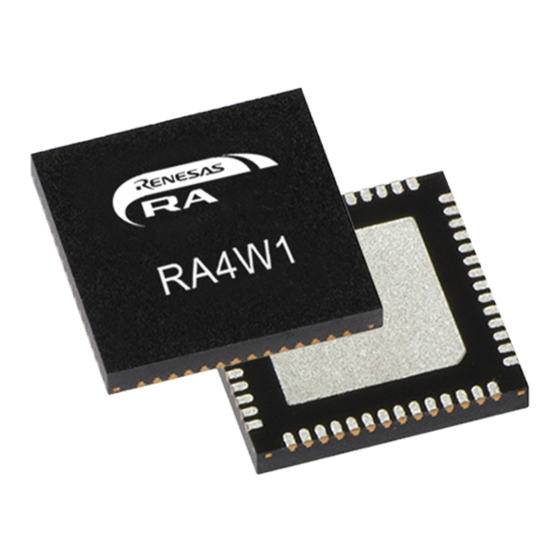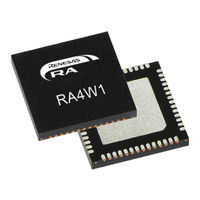
Renesas RA4W1 Manuals
Manuals and User Guides for Renesas RA4W1. We have 2 Renesas RA4W1 manuals available for free PDF download: User Manual, Application Note
Renesas RA4W1 User Manual (1317 pages)
32-bit MCU
Brand: Renesas
|
Category: Microcontrollers
|
Size: 17 MB
Table of Contents
-
Features
47 -
1 Overview
48-
Pin Lists61
-
2 Cpu
64-
Overview64
-
Debug64
-
-
Debug Mode67
-
-
Reset67
-
-
References78
-
-
-
Overview80
-
-
6 Resets
87 -
-
Overview99
-
Usage Note108
-
-
-
Overview109
-
-
Monitoring Vdet0113
-
Monitoring Vdet1113
-
-
-
-
Overview117
-
-
PLL Circuit146
-
Internal Clock146
-
USB Clock (UCLK)148
-
Clocks for BLE149
-
Usage Notes149
-
-
-
Overview151
-
-
Operation157
-
Usage Note159
-
-
-
Overview160
-
-
Sleep Mode179
-
Snooze Mode183
-
Usage Notes189
-
Register Access189
-
I/O Port States190
-
-
-
-
Overview193
-
-
Operation204
-
Usage Notes208
-
-
-
Overview209
-
-
-
Overview210
-
-
Vector Table223
-
Event Number224
-
Reference234
-
-
15 Buses
235-
Overview235
-
-
Main Buses236
-
Slave Interface236
-
-
References242
-
-
-
Overview243
-
-
Arm MPU251
-
Bus Master MPU251
-
Operation256
-
Bus Slave MPU259
-
-
Functions264
-
-
Security MPU264
-
-
Notes on Debug273
-
-
References273
-
-
-
Overview274
-
-
Operation285
-
Interrupts299
-
Event Link300
-
Usage Notes301
-
-
-
Overview302
-
-
Operation311
-
Interrupt Source325
-
Event Link325
-
-
-
Overview327
-
Operation333
-
Usage Notes334
-
-
20 I/O Ports
335-
Overview335
-
Operation342
-
Usage Notes345
-
-
-
Overview361
-
Usage Notes366
-
-
-
Overview367
-
-
Operation409
-
Basic Operation409
-
Buffer Operation420
-
-
Usage Notes486
-
-
-
Overview489
-
-
Operation498
-
Timer Mode500
-
Standby Mode507
-
Usage Notes508
-
Digital Filter509
-
-
-
Overview511
-
-
-
(Bcnt0Cp0)534
-
-
Operation537
-
Setting the Time538
-
Alarm Function541
-
Usage Notes547
-
-
-
Overview550
-
Operation556
-
-
Auto Start Mode558
-
Reset Output561
-
-
Usage Notes562
-
-
-
Overview563
-
Operation568
-
Auto Start Mode568
-
Status Flags570
-
Reset Output571
-
-
Usage Notes572
-
-
-
Overview573
-
-
Operation620
-
System Control620
-
-
BRDY Interrupt629
-
NRDY Interrupt632
-
BEMP Interrupt634
-
VBUS Interrupt637
-
Resume Interrupt638
-
OVRCR Interrupt638
-
BCHG Interrupt638
-
DTCH Interrupt638
-
SACK Interrupt638
-
SIGN Interrupt638
-
ATTCH Interrupt638
-
EOFERR Interrupt638
-
-
Pipe Control639
-
Transfer Types640
-
Endpoint Number640
-
Response PID641
-
OUT-NAK Mode642
-
Pipe Schedule655
-
-
Usage Notes661
-
Advertisement
Renesas RA4W1 Application Note (20 pages)
Guidelines for 2.4 GHz Wireless Board Design
Brand: Renesas
|
Category: Motherboard
|
Size: 0 MB
Table of Contents
-
Overview3
-
Power Supply14
-
Ground14

